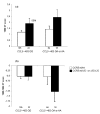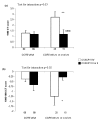Polymorphisms in chemokine and chemokine receptor genes and the development of coal workers' pneumoconiosis
- PMID: 16524739
- PMCID: PMC1913495
- DOI: 10.1016/j.cyto.2006.01.001
Polymorphisms in chemokine and chemokine receptor genes and the development of coal workers' pneumoconiosis
Abstract
Chemokines and their receptors are key regulators of inflammation and may participate in the lung fibrotic process. Associations of polymorphisms in CCL5 (G-403A) and its receptor CCR5 (Delta32), CCL2 (A-2578G) and CCR2 (V64I), and CX3CR1 V249I and T280M with coal worker's pneumoconiosis (CWP) were investigated in 209 miners examined in 1990, 1994 and 1999. Coal dust exposure was assessed by job history and ambient measures. The main health outcome was lung computed tomography (CT) score in 1990. Internal coherence was assessed by studying CT score in 1994, 4-year change in CT score, and CWP prevalence in 1999. CCR5 Delta32 carriers had significantly higher CT score in 1990 and 1994 (2.15 vs. 1.28, p=0.01; 3.04 vs. 1.80, p=0.04). The CX3CR1 I249 allele was significantly associated with lower 1990 CT score and lower progression in 4-year change in CT score in CCR5 Delta32 carriers only (p for interaction=0.03 and 0.02). CX3CR1 V249I was associated with lower 1999 CWP prevalence (16.7%, 13.2%, 0.0% for VV, VI and II); the effect was most evident in miners with high dust exposure (31.6%, 21.7%, 0.0%). Our findings indicate that chemokine receptors CCR5 and CX3CR1 may be involved in the development of pneumoconiosis.
Figures



Similar articles
-
IL18 and IL18R1 polymorphisms, lung CT and fibrosis: A longitudinal study in coal miners.Eur Respir J. 2006 Dec;28(6):1100-5. doi: 10.1183/09031936.00031506. Epub 2006 Sep 13. Eur Respir J. 2006. PMID: 16971411
-
The role of chemokine and chemokine receptor gene variants on the susceptibility and clinicopathological characteristics of bladder cancer.Gene. 2012 Dec 10;511(1):7-11. doi: 10.1016/j.gene.2012.09.011. Epub 2012 Sep 14. Gene. 2012. PMID: 22982413
-
Polymorphisms of chemokine and chemokine receptor genes in idiopathic immune-mediated posterior segment uveitis.Mol Vis. 2007 Mar 23;13:388-96. Mol Vis. 2007. PMID: 17417600 Free PMC article.
-
Genetic polymorphisms in the chemokine and chemokine receptors: impact on clinical course and therapy of the human immunodeficiency virus type 1 infection (HIV-1).Curr Med Chem. 2007;14(12):1325-34. doi: 10.2174/092986707780597934. Curr Med Chem. 2007. PMID: 17504215 Review.
-
Polymorphisms in CCL2&CCL5 chemokines/chemokine receptors genes and their association with diseases.Biomed Pap Med Fac Univ Palacky Olomouc Czech Repub. 2006 Nov;150(2):191-204. doi: 10.5507/bp.2006.028. Biomed Pap Med Fac Univ Palacky Olomouc Czech Repub. 2006. PMID: 17426779 Review.
Cited by
-
Selective elevation of circulating CCL2/MCP1 levels in patients with longstanding post-vaccinal macrophagic myofasciitis and ASIA.Curr Med Chem. 2014;21(4):511-7. doi: 10.2174/09298673113206660287. Curr Med Chem. 2014. PMID: 24083602 Free PMC article.
-
Candidate gene polymorphisms associated with silicosis and coal workers' pneumoconiosis: a systematic review and meta-analysis.BMC Pulm Med. 2024 Nov 22;24(1):580. doi: 10.1186/s12890-024-03392-0. BMC Pulm Med. 2024. PMID: 39578762 Free PMC article.
-
Evidence of positive selection at codon sites localized in extracellular domains of mammalian CC motif chemokine receptor proteins.BMC Evol Biol. 2010 May 10;10:139. doi: 10.1186/1471-2148-10-139. BMC Evol Biol. 2010. PMID: 20459756 Free PMC article.
References
-
- Power CA. Knock out models to dissect chemokine receptor function in vivo. J Immunol Methods. 2003;273:73–82. - PubMed
-
- Gerard G, Rollins BJ. Chemokines and disease. Nature Immunol. 2001;2:108–115. - PubMed
-
- McGinnis R, Child F, Clayton S, Davies S, Lenney W, Illig T, Wjst M, Spurr N, Debouck C, Hajeer AH, Ollier WER, Strange R, Fryer AA. Further support for the association of CCR5 allelic variants with asthma susceptibility. Eur J Immunogenet. 2002;29:525–528. - PubMed
-
- Petrek M, Drabek J, Kolek V, Zlamal J, Welsh I, Bunce M, Weigl E, du Bois RM. CC Chemokine receptor gene polymorphisms in Czech patients with pulmonary sarcoidosis. Am J Respir Crit Care Med. 2000;162:1000–1003. - PubMed
Publication types
MeSH terms
Substances
Grants and funding
LinkOut - more resources
Full Text Sources

